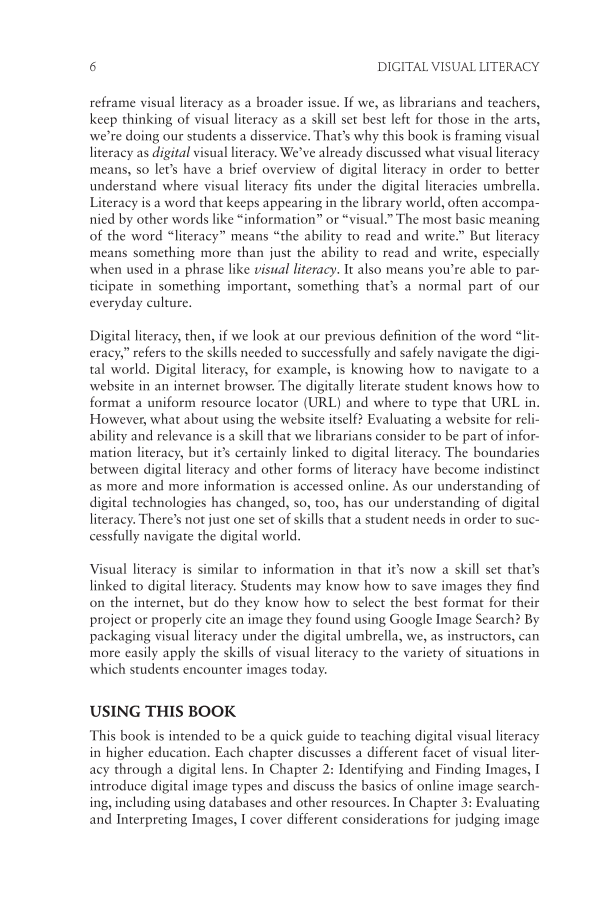6 DIGITAL VISUAL LITERACY reframe visual literacy as a broader issue. If we, as librarians and teachers, keep thinking of visual literacy as a skill set best left for those in the arts, we’re doing our students a disservice. That’s why this book is framing visual literacy as digital visual literacy. We’ve already discussed what visual literacy means, so let’s have a brief overview of digital literacy in order to better understand where visual literacy fits under the digital literacies umbrella. Literacy is a word that keeps appearing in the library world, often accompa- nied by other words like “information” or “visual.” The most basic meaning of the word “literacy” means “the ability to read and write.” But literacy means something more than just the ability to read and write, especially when used in a phrase like visual literacy. It also means you’re able to par- ticipate in something important, something that’s a normal part of our everyday culture. Digital literacy, then, if we look at our previous definition of the word “lit- eracy,” refers to the skills needed to successfully and safely navigate the digi- tal world. Digital literacy, for example, is knowing how to navigate to a website in an internet browser. The digitally literate student knows how to format a uniform resource locator (URL) and where to type that URL in. However, what about using the website itself? Evaluating a website for reli- ability and relevance is a skill that we librarians consider to be part of infor- mation literacy, but it’s certainly linked to digital literacy. The boundaries between digital literacy and other forms of literacy have become indistinct as more and more information is accessed online. As our understanding of digital technologies has changed, so, too, has our understanding of digital literacy. There’s not just one set of skills that a student needs in order to suc- cessfully navigate the digital world. Visual literacy is similar to information in that it’s now a skill set that’s linked to digital literacy. Students may know how to save images they find on the internet, but do they know how to select the best format for their project or properly cite an image they found using Google Image Search? By packaging visual literacy under the digital umbrella, we, as instructors, can more easily apply the skills of visual literacy to the variety of situations in which students encounter images today. USING THIS BOOK This book is intended to be a quick guide to teaching digital visual literacy in higher education. Each chapter discusses a different facet of visual liter- acy through a digital lens. In Chapter 2: Identifying and Finding Images, I introduce digital image types and discuss the basics of online image search- ing, including using databases and other resources. In Chapter 3: Evaluating and Interpreting Images, I cover different considerations for judging image
Document Details My Account Print multiple pages
Print
You have printed 0 times in the last 24 hours.
Your print count will reset on at .
You may print 0 more time(s) before then.
You may print a maximum of 0 pages at a time.









































































































